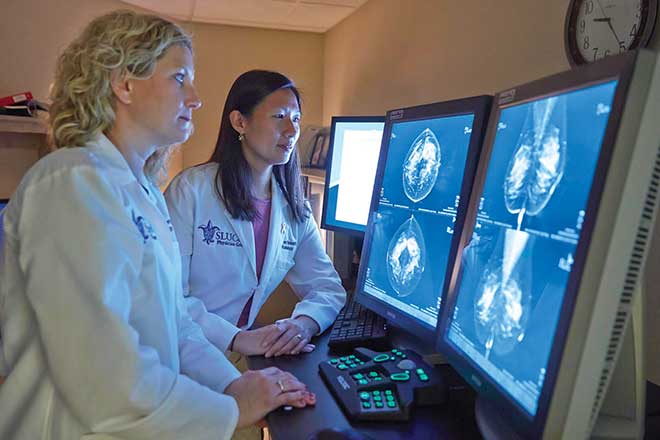You get a mammogram. A few weeks later, a letter arrives in the mail saying you have dense breasts and could be at a higher risk for breast cancer. It sounds terrifying, but there’s no need to panic, says SLUCare breast radiologist Dr. Debbie Bennett. “About half of all women have dense breasts. It’s not a disease, and it’s not abnormal. It’s how half the population is normally made.”
Studies show that dense tissues increase the risk of a woman getting breast cancer over her lifetime “by about 1.2 times, or as much as two times for really dense breasts, which only 2 percent of women have,” Bennett says. Glandular tissue also makes it more difficult for a radiologist to detect tumors in a regular mammogram. The statistics are scary, but Bennett cautions that most women have no need for increased alarm. “I think it’s useful to know if you have dense breasts, but I don’t think it’s useful for most people to worry about it.”
Despite recent awareness of breast density, screening advice remains largely unchanged, Bennett says. Women in their 20s and 30s should have a clinical breast exam every three years, and every year by age 40. After age 40, women should also have a mammogram every year for as long as they are in good health. Screening may start earlier for women who are at high risk for breast cancer, including those with strong family history of the disease, who have a known BRCA1 or BRCA2 gene mutation, and those who’ve had several benign breast biopsies.”
The upside of so much focus being placed on dense breasts, Bennett says, is increased discussions between patients and doctors about tailored screenings, such as 3-D mammograms. “They find more cancers than regular mammograms,” she says. “There’s great benefit for women with dense breasts, because those are the women in whom it’s harder to find breast cancer on regular mammograms.”
Understanding the common nature of dense breasts can allow women to breathe a little easier when their post-mammogram letter shows up, Bennett says. They may find further solace, she says, in having their mammograms read by a breast specialist, who is “much more likely to notice subtle changes that could be the first signs of breast cancer,” she says. “They also are really passionate about breast cancer, so if you have to come back in for more pictures or a biopsy, you get to talk to someone who really cares about your well-being and your breast health.”
[SLUCare breast radiologists specialize in breast screening and diagnostic evaluation. Pictured on the cover: SLUCare breast radiologists Drs. Debbie Bennett, Christina Doherty and Catherine Lowdermilk, who practice at SSM Health St. Mary’s Hospital, 6420 Clayton Road, and SSM Health St. Louis University Hospital, 3655 Vista Ave. For more information, call 314.768.8353 or 314.577.8022.]
Pictured: Breast radiologists Drs. Christina Doherty and Debbie Bennett
Photo courtesy of SLUCare Physician Group
Cover design by allie bronsky | Cover photo courtesy of slucare
